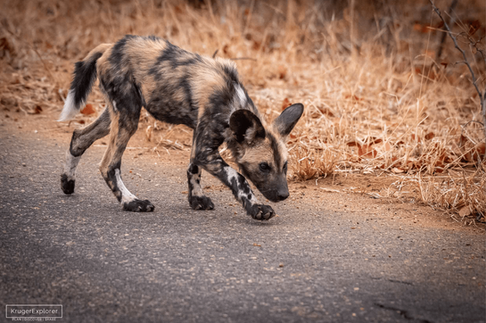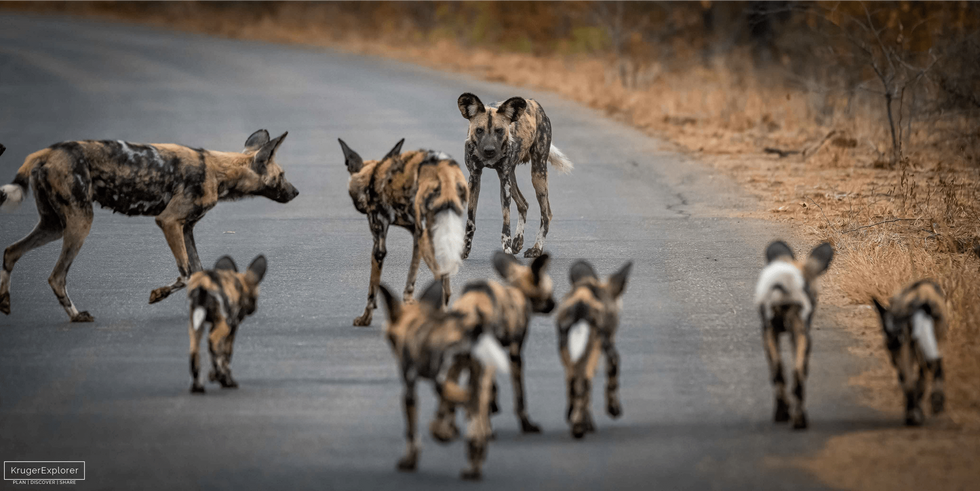The Wild Dog Puppies of Punda Maria
- KrugerExplorer

- Mar 31, 2020
- 9 min read
To all our followers, blog readers and KrugerExplorer App users...
We hope you are all safe and healthy during these unprecedented times. Never did we think we’d be writing a blog post as the world moves into a global lockdown to combat a pandemic. The terrible situation immediately brings into focus how lucky we have been to travel and explore wonderful wilderness areas, as well as share these adventures with you.
We are using our time in lockdown to post actively on Instagram and Facebook, add new species to the KrugerExplorer App (see details below) and write blog posts, like this one about the amazing Wild Dog puppies encounter that we enjoyed! We hope that all these things may bring you a little joy and escape wherever you may be in the world.
With Kruger National Park closed and many visitors having been forced to cancel or postpone trips, it is also a challenging time for the tourism sector in the Kruger region.
Our KrugerExplorer App project is of course facing a similar challenge but if you are in lockdown or self-isolation, downloading the App can help you ‘escape’ by immersing you in the natural wonder of Kruger from the comfort and safety of home. It is also a superb education tool for children who may be unable to attend school.
We’d be so incredibly grateful for the support during this difficult time and you can click the App Store / Google Play icons below to check it out.
Stay safe and wishing you all the very best during these exceptionally challenging days.
Best regards
Danny & Charlotte x
The Wild Dog Puppies of Punda Maria
When we set out from Punda Maria to Shingwedzi, we had some excellent plans for the journey we would take, exploring the various side roads that lead away from the main tarred road between the two rest camps.

But just minutes after driving through the gate of Punda Maria onto the H13-2, the plans were quickly forgotten…
I asked Charlotte what she would most like to see during the drive and she opted for wild dog puppies, which of course received an appropriate eye-roll because they are not exactly the easiest of species to find in Kruger.
Incredibly, within a matter of seconds two very large wild dogs sprinted across the road in front of us! They vanished into the bush on the left of the vehicle almost as quickly as they had appeared. Searching frantically to keep a visual on them, I glanced over my shoulder on the other side of the car to see a small army of wild dog pups scurrying along, flanked by several other adults!
They bounded into the road in front of us, full of energy and playful mischief. Heart pounding with excitement, we began one of the most challenging wildlife photography sessions I’ve ever known! These guys don’t stop running, it was very cloudy and almost dark, and trying to drive slowly to keep up with them while taking photos out of the window was complicated to say the least!
Over the next 15-minutes, we had one of our best ever Kruger sightings. More and more pups emerged and played in the road and grassy verges while the adults shepherded them from sprinting off too far. We counted 10 adults and 18 pups although we would not bet much on that being 100% correct given the incredible amount of movement going on all around us!
We took a great number of images in these very difficult conditions – many went in the bin but I hope some of these bring to life our experience for you.
The rest of this blog is an extract of the wild dog profile found in our KrugerExplorer App and we hope it enhances your knowledge of this amazing but critically endangered species.
AFRICAN WILD DOG

Introduction
The spectacular African wild dog is a dog species found in Kruger National Park. There are fewer than 300 wild dog found in the park, yet its diurnal nature and highly active behaviour means that sightings are surprisingly frequent and a real highlight of any safari drive.
An endangered species across Africa with fewer than 6,000 remaining in the wild, the wild dog has long come into conflict with keepers of livestock which has seen a decimation of population and resulted in highly fragmented geographical ranges. Limited genetic diversity increases susceptibility to disease and bouts of rabies and canine distemper can have major impacts on numbers. These combined factors leave the wild dog a species deeply threatened by the spectre of extinction.
Recently, people have started referring to this species as the ‘painted wolf’. This comes from a more literal translation of its scientific name lyacon pictus (“painted wolf-like” or “painted wolf-kind”) and is interesting because the change is largely driven by conservation goals.
Unfortunately, the name ‘wild dog’ is often confused with ‘feral dog’ (as in a homeless domesticated dog), undermining conservation efforts because it is hard to convince someone that the millions of feral dogs in cities around the world need saving from extinction! By naming them something more adventurous, the hope is that the difference between this species and a feral dog will be better understood and more people will support efforts to ensure the incredible African wild dog does not become extinct.
It is also worth noting that the African wild dog is not the ancestor of our domesticated dogs. The dogs that we have as pets are descended from the now extinct Eurasian wolf and were domesticated by people living across the Eurasian landmass. Domestic dogs share this common wolf ancestor with the grey wolf that is still present in the wild across this range, but they are sister taxa and so the dogs are not domesticated versions of today’s grey wolf either – the two split from the single extinct ancestor some 20-40,000 years ago.
All dog and wolf species are part of the genus Canis and this includes today’s African wild dog, but you must trace the lineage of the wild dog back much further to find a common ancestor with domestic dogs and the grey wolf, so much so that is could easily be argued that the African wild dog is not really a species of wolf or dog, but actually deserves its own more unique name, much like those of other distantly-related canids, such as jackals, foxes and coyotes.
Physical characteristics
The wild dog is tall and slender and unmistakable as a dog species. It is a beautiful animal with incredibly varied and irregular fur coats. The colours include black, dark brown, tan and white and they can present in patterns as varied as patches, spots and rosettes, giving the characteristic ‘painted on’ look.
The ears are large and round and there is usually a darker line down the centre of the forehead between the ears and eyes. The muzzle is relatively short and more often dark coloured. The tail often has a brilliant white tuft of fur at the end.
Sexual dimorphism is largely absent beyond sexual organs, with males and females being very similar in both size and weight.
Diet
The wild dog is a carnivorous predator. Prey includes anything from small mammals such as hares up to large antelope species including kudu, although mid-sized antelope such as impala are most commonly taken. It rarely scavenges with vast majority of sustenance coming from hunting.
It will drink at water sources when available.
Habitat
The wild dog is typically found in grassy plains, savannah or open woodland as it requires clear spaces for its hunting techniques. Any terrain with dense bush or tall grasses is avoided.
It occupies a similar point in the food-chain as lions and spotted hyenas, but the wild dog is usually out-competed by these animals so it tends to be found in areas where numbers of these rivals is lower.
A diurnal species, the wild dog is active throughout the day although hunting tends to take place during the early morning or late afternoon.
Behaviours
The wild dog is a highly social animal, spending all of its life in large family groups called packs. The packs are dominated by an alpha male and female pairing and while competition for top spot is common, it rarely leads to full fighting or violence. Packs typically include 10 to 15 dogs although larger packs can occur.
Hunting is a communal activity involving all able adults in the pack. The start of a hunt is met with a great fanfare of rallying that includes yelping, darting around and sneezing and is quite a scene. If the dominant pair sneeze repeatedly, a hunt is very likely to occur.
The hunting techniques are sophisticated and rely on long distance stamina - once prey is targeted, the individual animal is chased by the pack until exhaustion, at which point the pack closes in and pounces on the unfortunate victim for a rapid end. Attacking line formations are adopted to prevent the quarry from escaping during the chase, with flanking and centre positions taken by the dogs most able to fulfil those roles.
Once a prey is captured, feeding follows an order that is unusual amongst higher predators, with the adolescents and non-dominant adults eating first, followed by the dominant adults.
Mating is usually conducted by the alpha pair only as non-alpha females do not come into oestrus. Gestation lasts for just 2-months and a litter of typically 7 to 10 pups is born, although as many as 18 or 19 have been recorded. As with domesticated dogs, the females have up to 12 or 14 mammae to be able to feed such a large litter. The young are born underground in a den.
Unusually for a carnivorous pack animal, the males remain with the pack of their birth once they reach adulthood and it is the females that leave and seek to join a different pack to maintain genetic diversity.
As mentioned above, wild dogs occupy a similar ecological point as lions and spotted hyena but are mostly unable to achieve local dominance over these powerful adversaries. Lions and hyena are the primary predators for wild dogs as a result of the conflicts that occur between them.
Where in Kruger?
The African wild dog is an endangered species and numbers within Kruger are commensurately low despite the park being a hugely important stronghold for this animal. Although the population is modest, sightings are relatively frequent owing to their being active during daylight hours.
The south of Kruger is undoubtedly the best place to hope to see wild dogs. The routes between the camps at Skukuza, Pretoriuskop, Berg-en-Dal and Crocodile Bridge, either via the outer loop that passes the various gates or through the interior, are all productive.
Further north, the sightings ranges are much reduced, with the following offering the best opportunities:
· S99 / Dimbo Hill Loop road in the plains area north of Punda Maria Camp.
· The plains area south of Mopani Camp, including the H1-6, S49 and S50.
· On either the H9 or H14 between Phalaborwa Gate and the Letaba and Mopani Camps.
· The western end of the H7 near the Orpen Gate and Orpen Camp.
· The H1-3 and surrounding roads along the S114, S119 and S25.
Did you know?
Wild dog hunting techniques are communal and involve chasing prey over long distances to the point of exhaustion. The flanking and use of terrain tactics adopted by the pack are so sophisticated that they have some of the highest hunting success rates of any predator with a kill ratio of over 75%. By contrast, lions and cheetah don’t register much above 40%.
There are however some limitations to this approach. Firstly, it necessitates living in terrain that is open and relatively flat for the strategy to be effective, reducing the range in which wild dogs can live. Secondly, the net expenditure of energy to make a kill is relatively high, meaning hunting expeditions need to happen quite frequently.
The kill is also likely to happen some distance from any den where cubs will have been left behind, making it difficult to feed them. However, the wild dog has a rather uncouth adaptation to manage this issue, whereby meat consumed at the kill site is regurgitated back at the den for young to eat. Furthermore, this food is also shared with old pack members who are unable to join hunts, as they perform an important role of remaining with the pups in the den as babysitters.
Kids’ corner!
Is that dog covered in paint?! African wild dogs are beautiful animals with amazing fur coats and patterns that sometimes look like the dog has managed to get itself covered in paint! It’s not really paint though - instead the markings allow the dogs to recognise each other when they are running very fast during hunts. Being able to easily see where each dog is means they are more likely to catch something for their dinner!
RECENT UPDATES to the KrugerExplorer App
We've been busy adding new content to the KrugerExplorer App recently!
There's an excellent new profile on the fascinating termites that can be found in Kruger National Park. Its remarkable to learn how many of their complex behaviours seem quite familiar to our own!
New bird profiles include a large extension of the Falcons, Hobbies & Kestrels, four new profiles from the Coursers & Pratincoles bird families, and new profiles covering the Black Stork, Black-throated Wattle-eye, Pied Crow. There's also some new images to help with identification - check out the breeding Little Grebe carrying two chicks on its back!
The KrugerExplorer App is the ultimate wildlife, maps and routes field guide to Kruger National Park. The App includes over 350 detailed animal profiles, hundreds of stunning photographic images and more than 70 wonderful journeys through Kruger.
It is the number 1 downloaded travel app in South Africa, has over 150 5-star reviews and has been featured by Apple as App of the Day.
Download it from the App Store or Google Play to immerse yourself in Kruger and its incredible wildlife from the comfort and safety of home.
Wishing all our followers all the very best during these unprecedented times.
Danny & Charlotte x


















































Thank you for sharing - what a wonderful post amid these uncertain times. I’ve never encountered a wild dog so it’s great to see such an array of photos. May future sightings like this continue for you both!